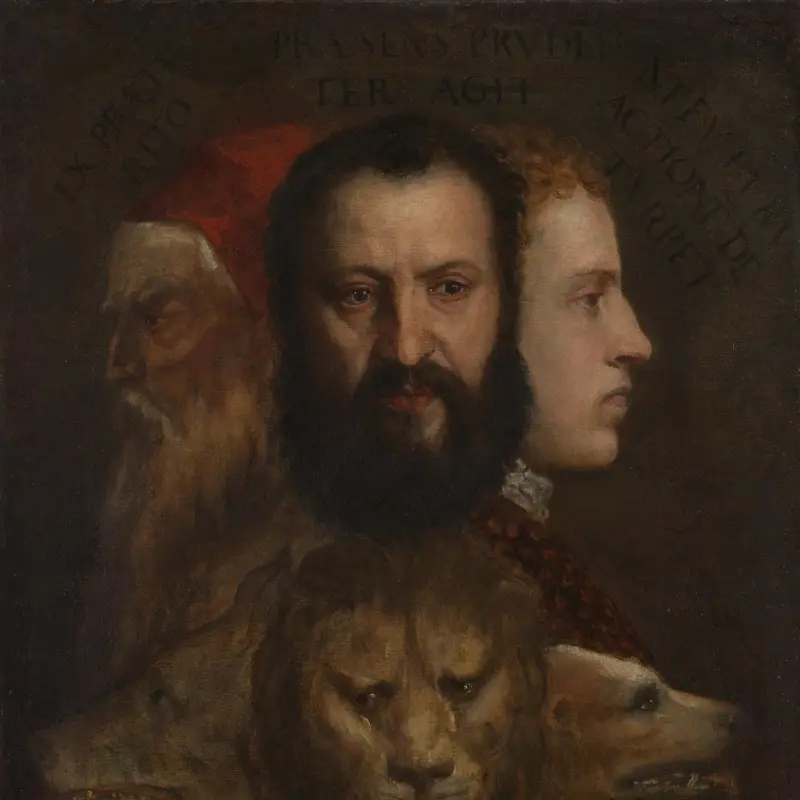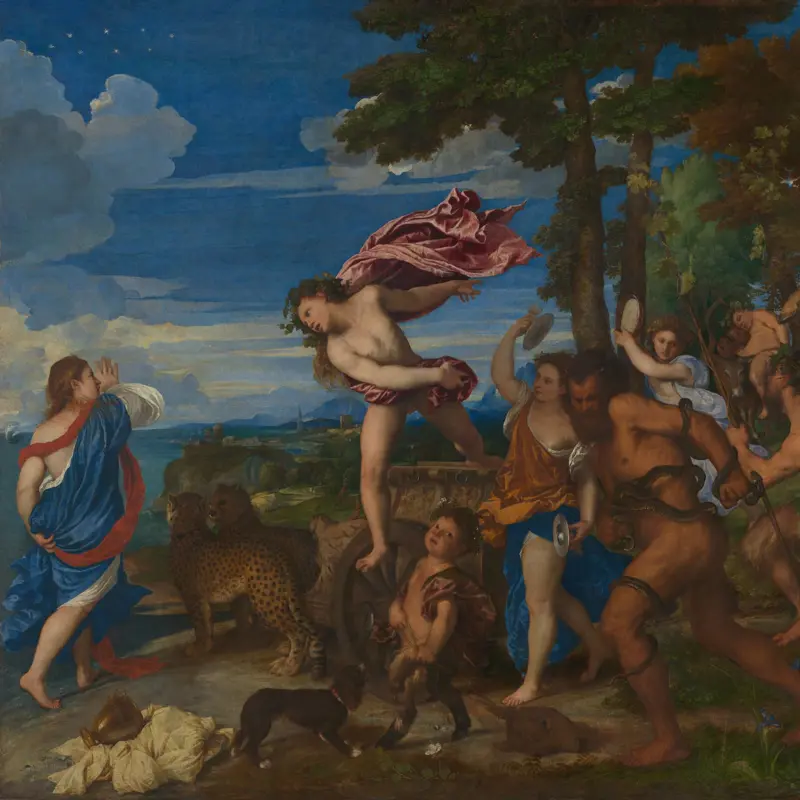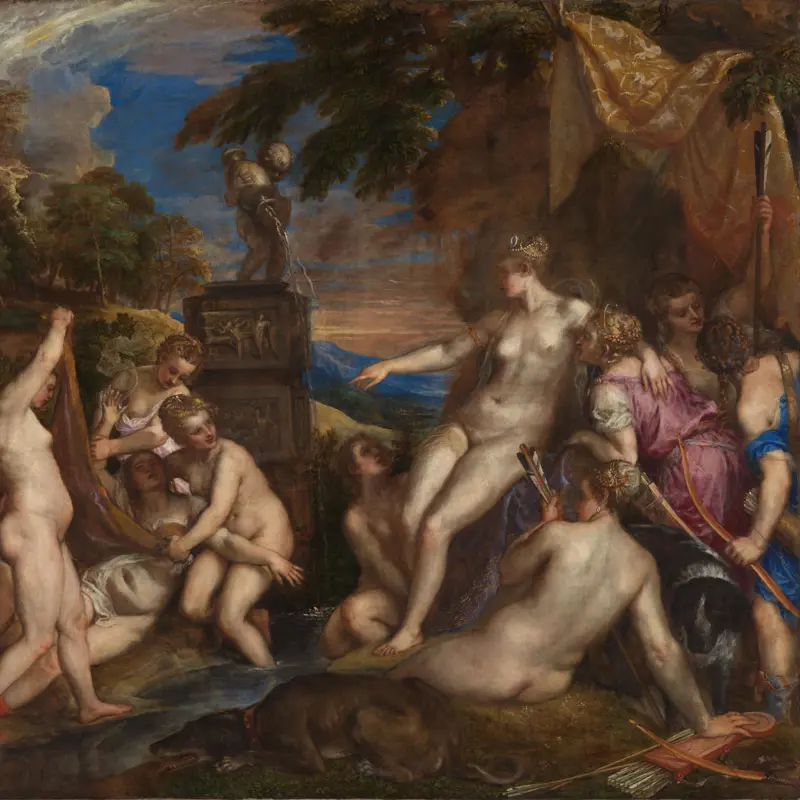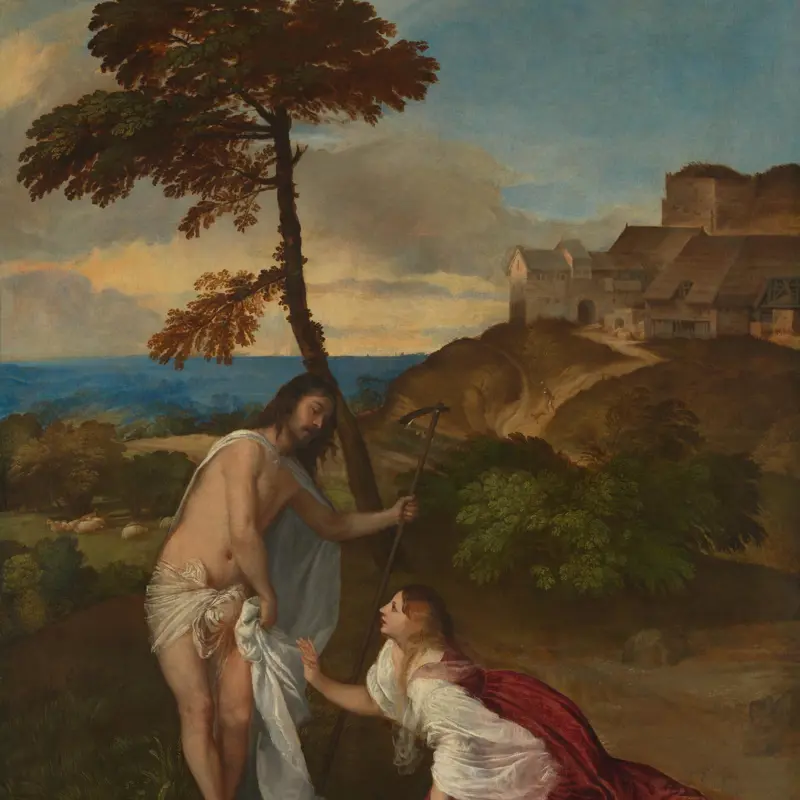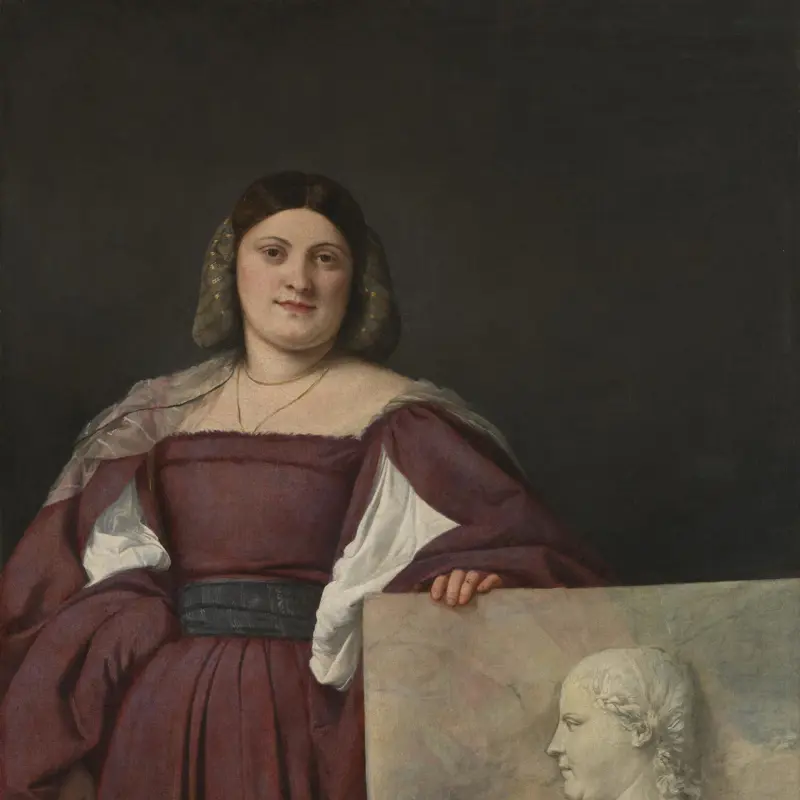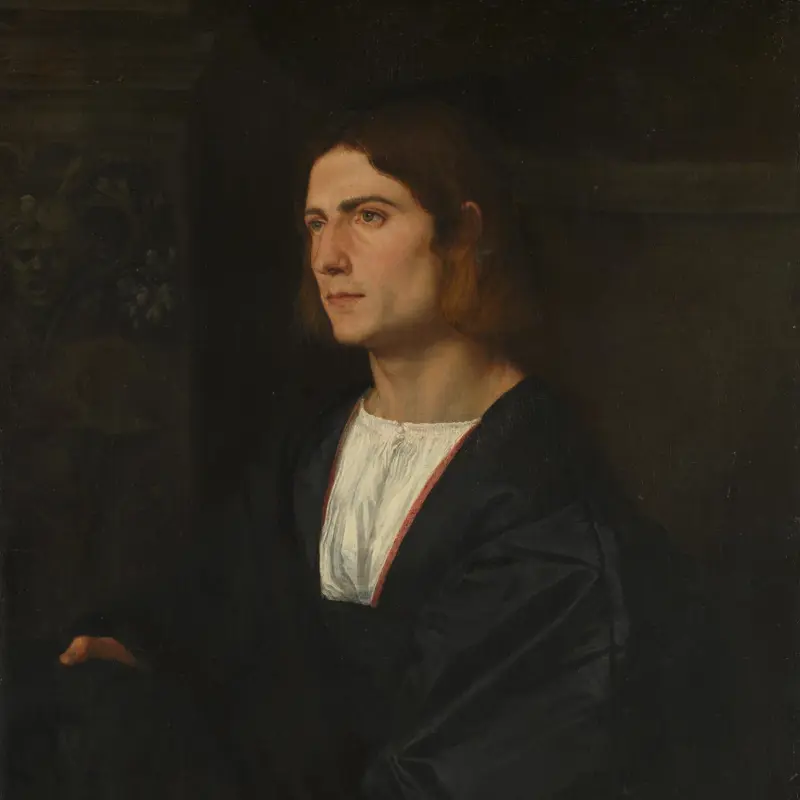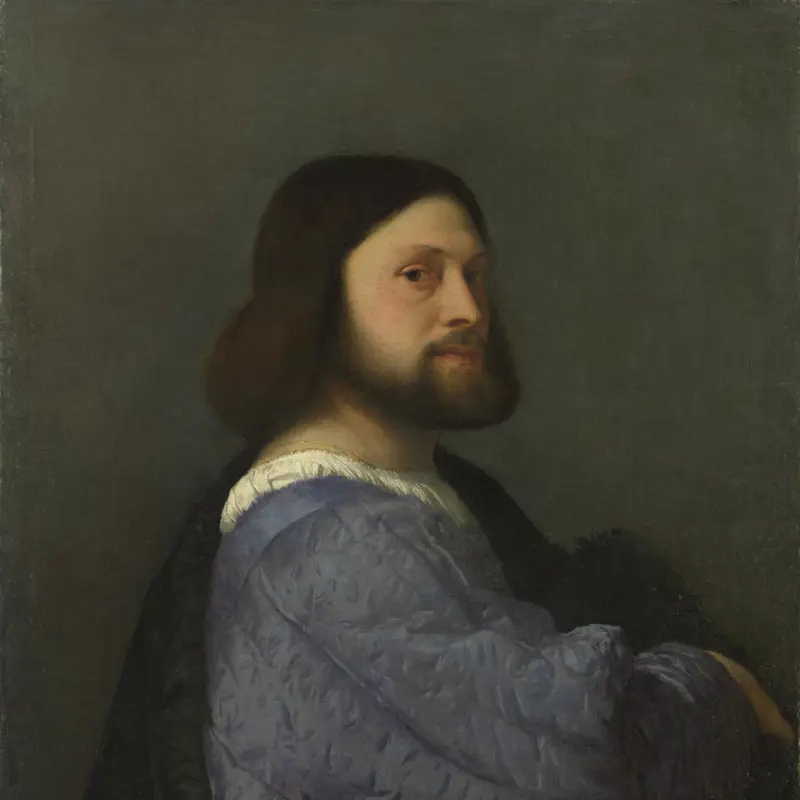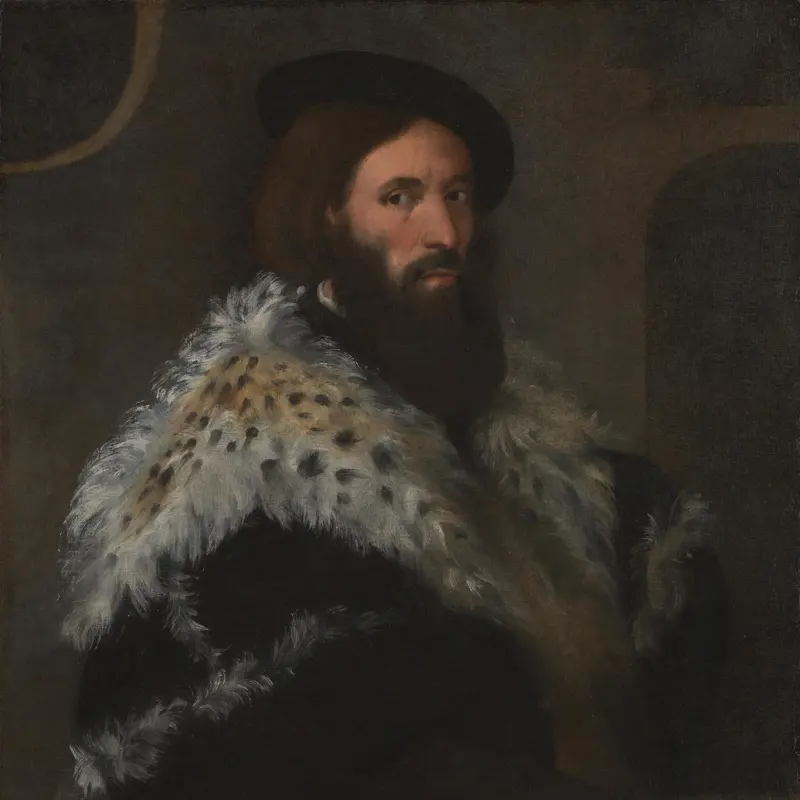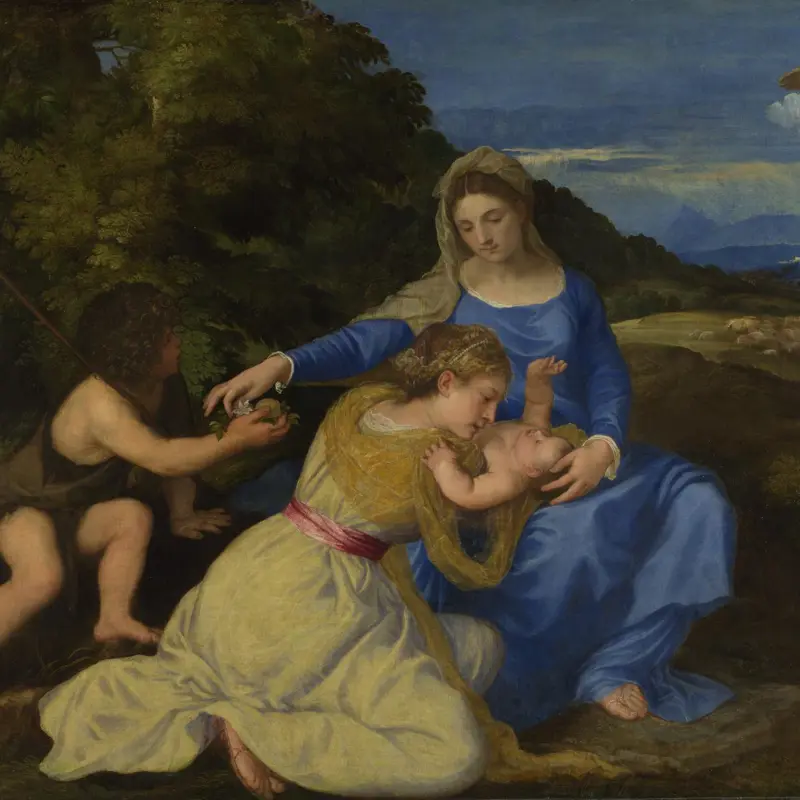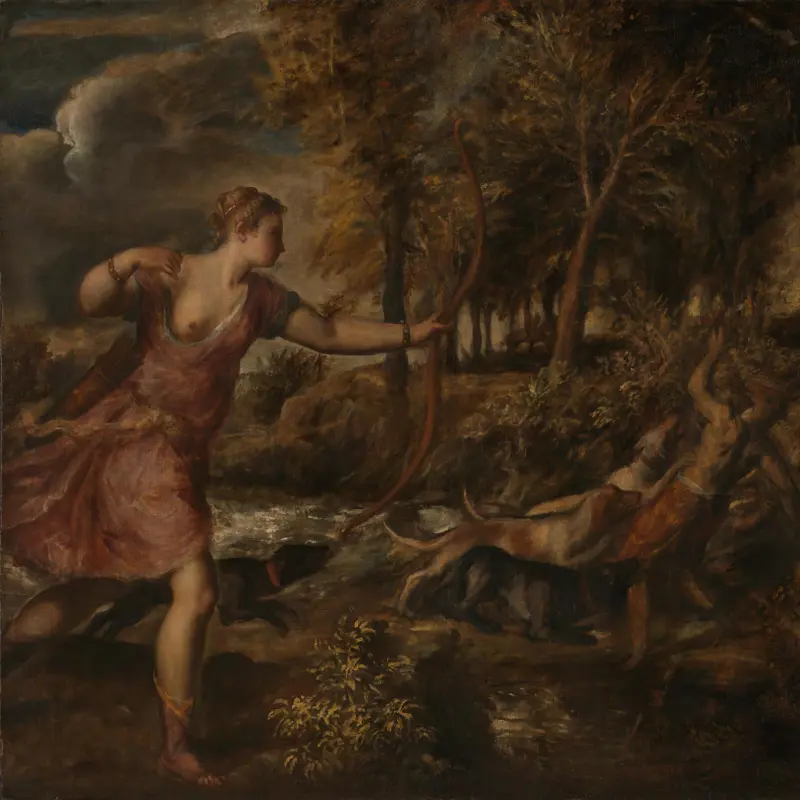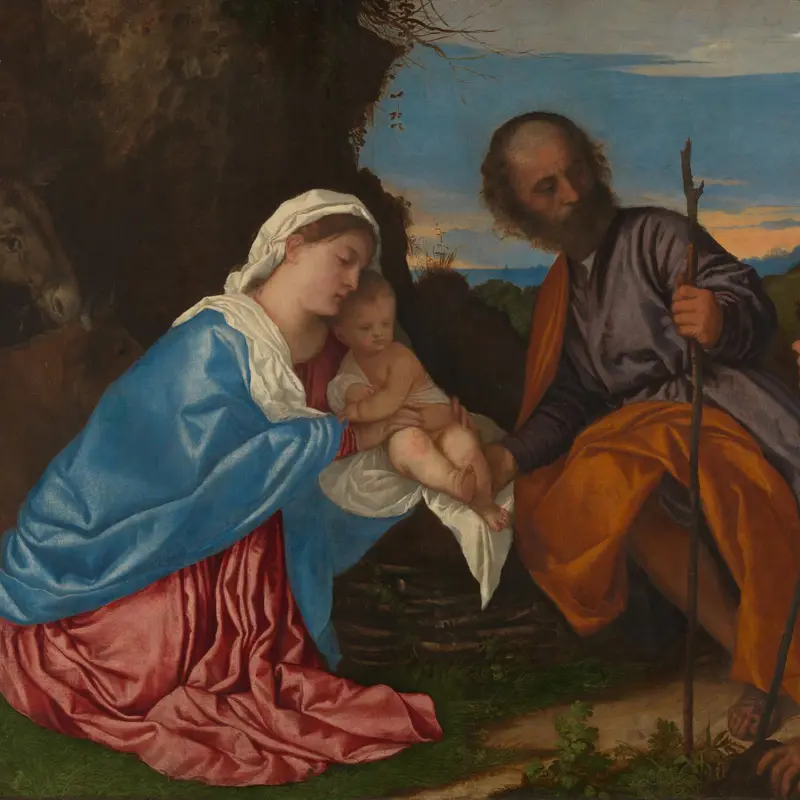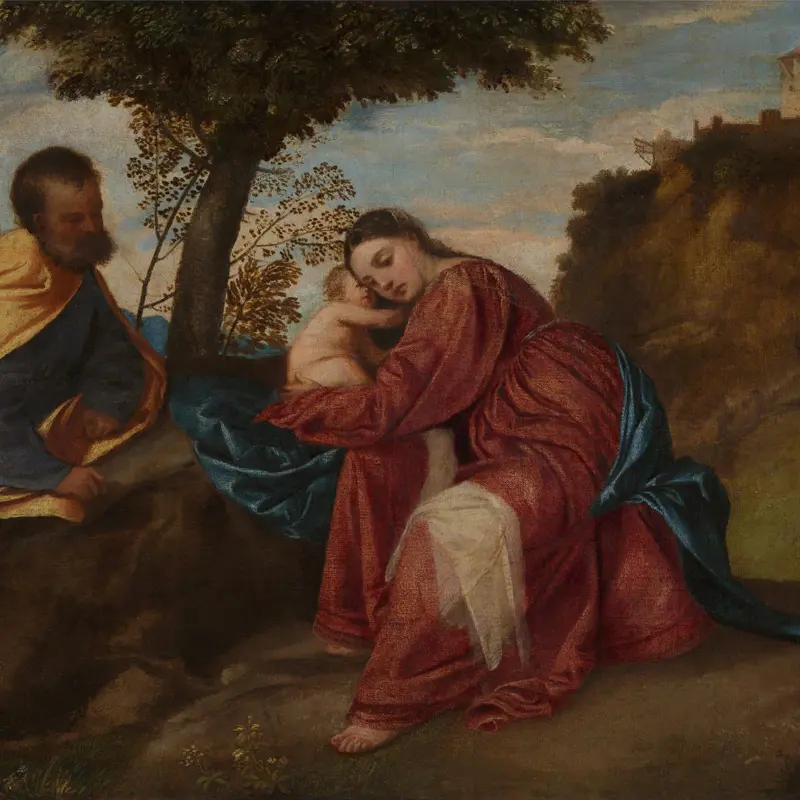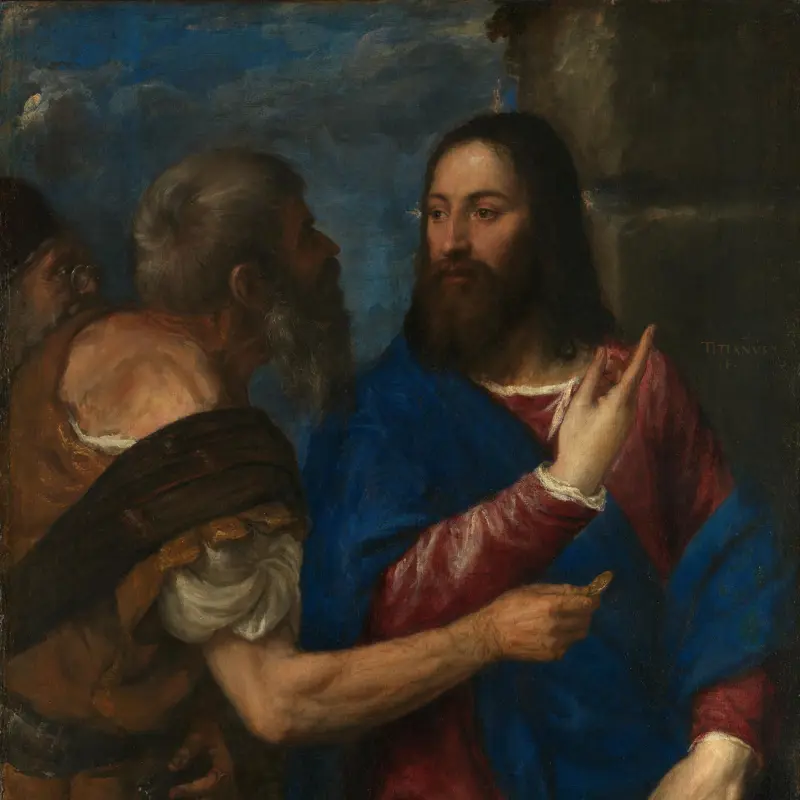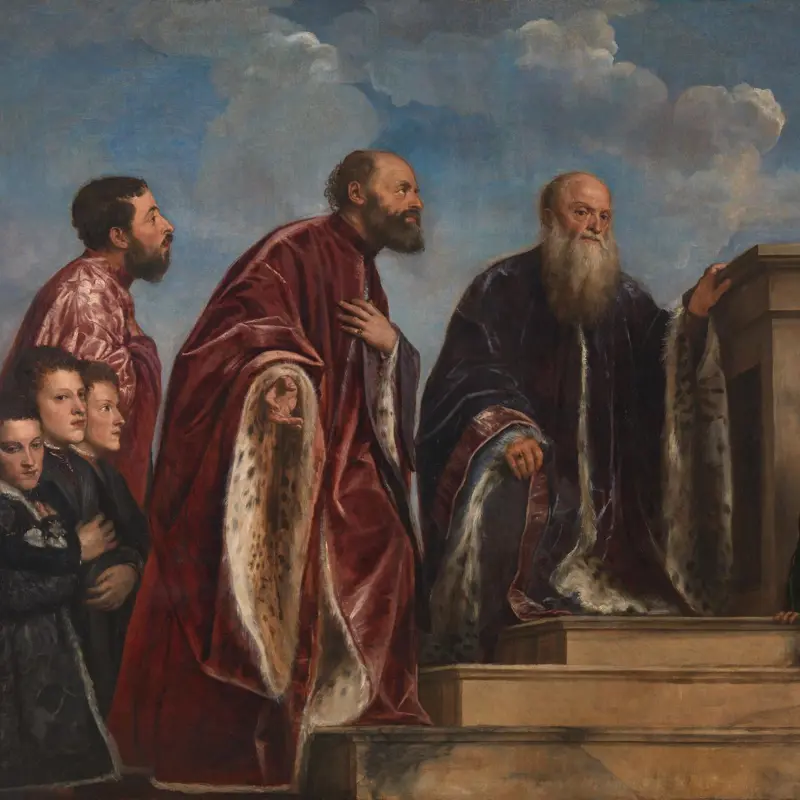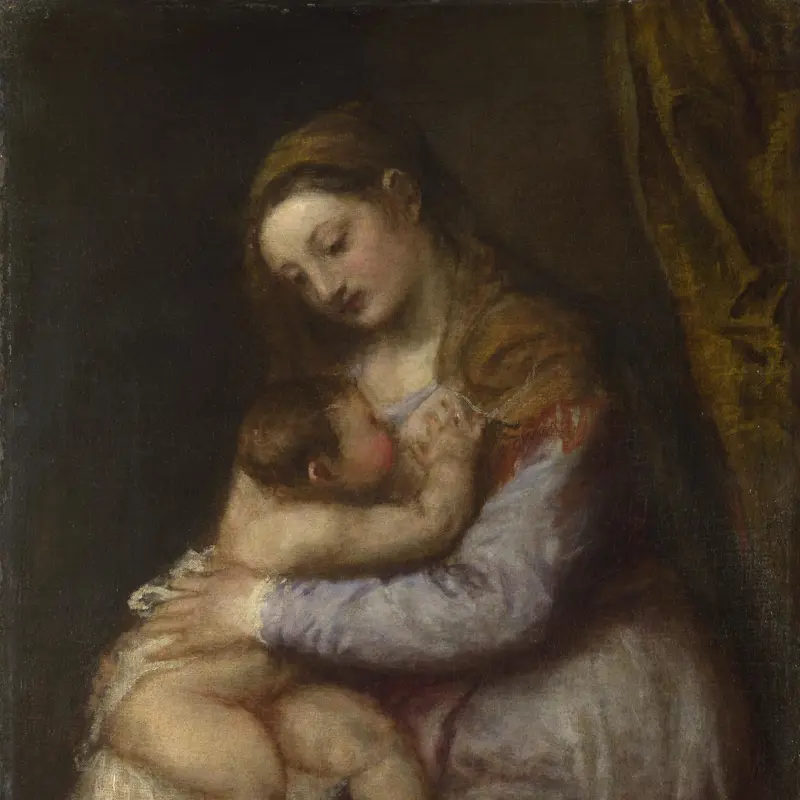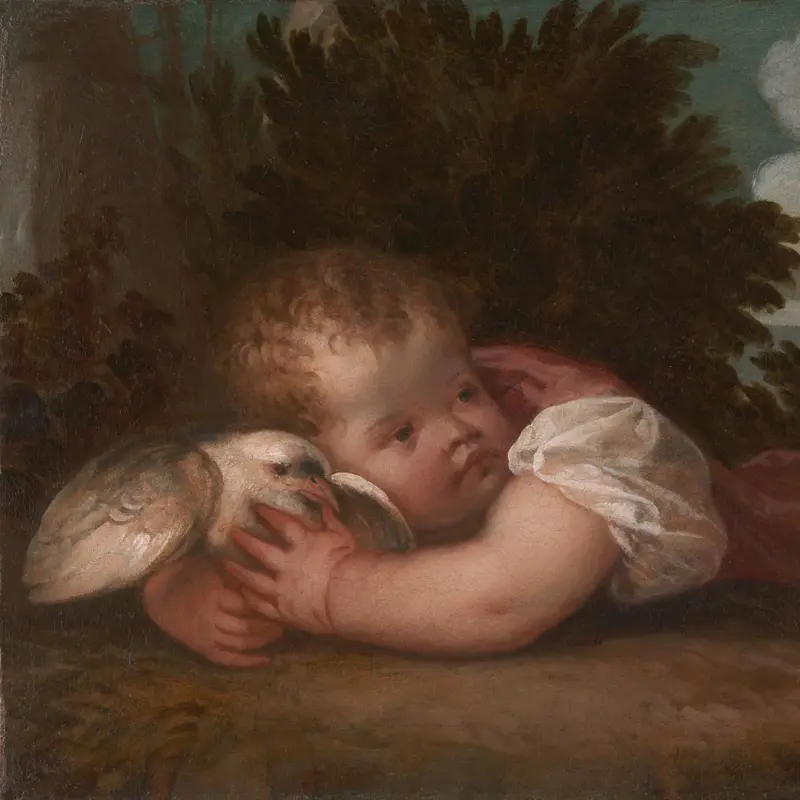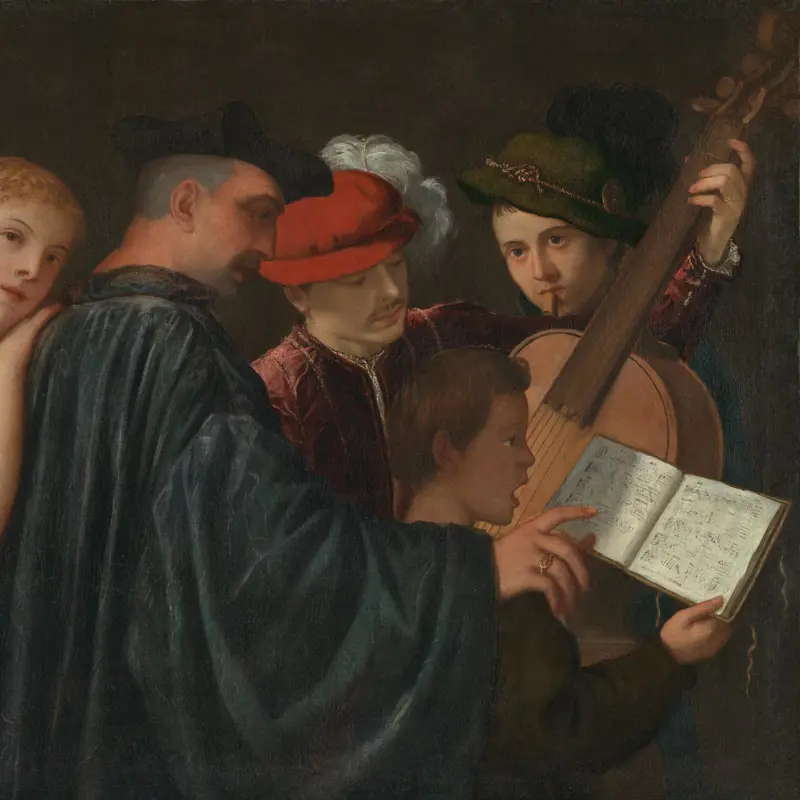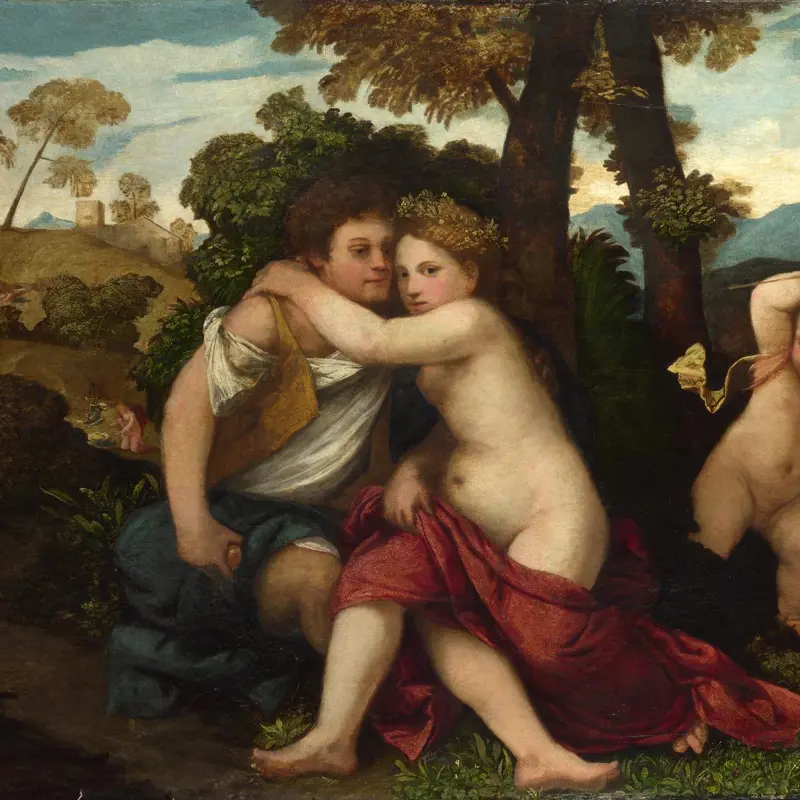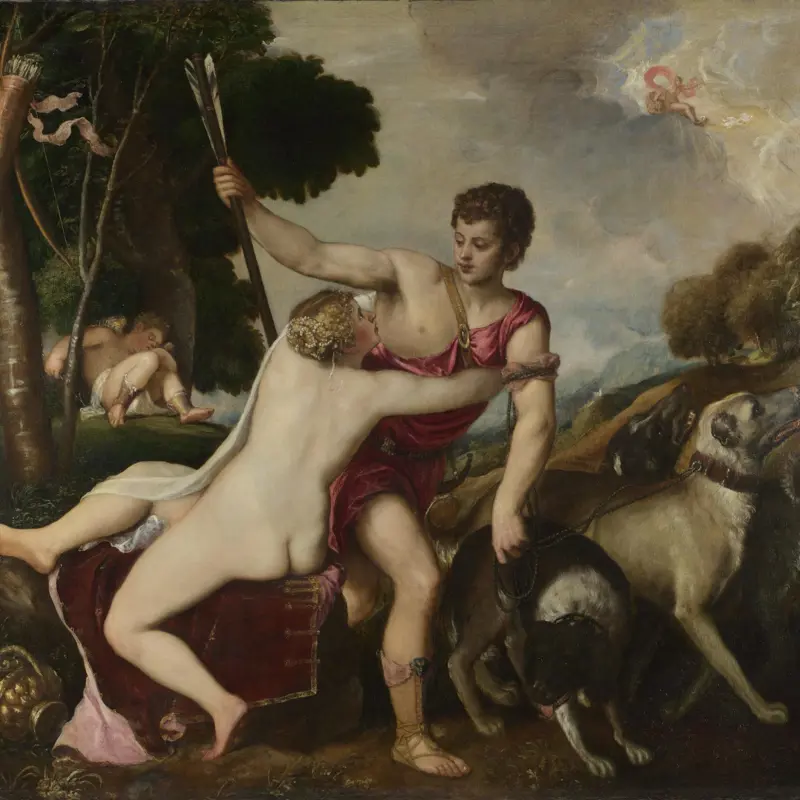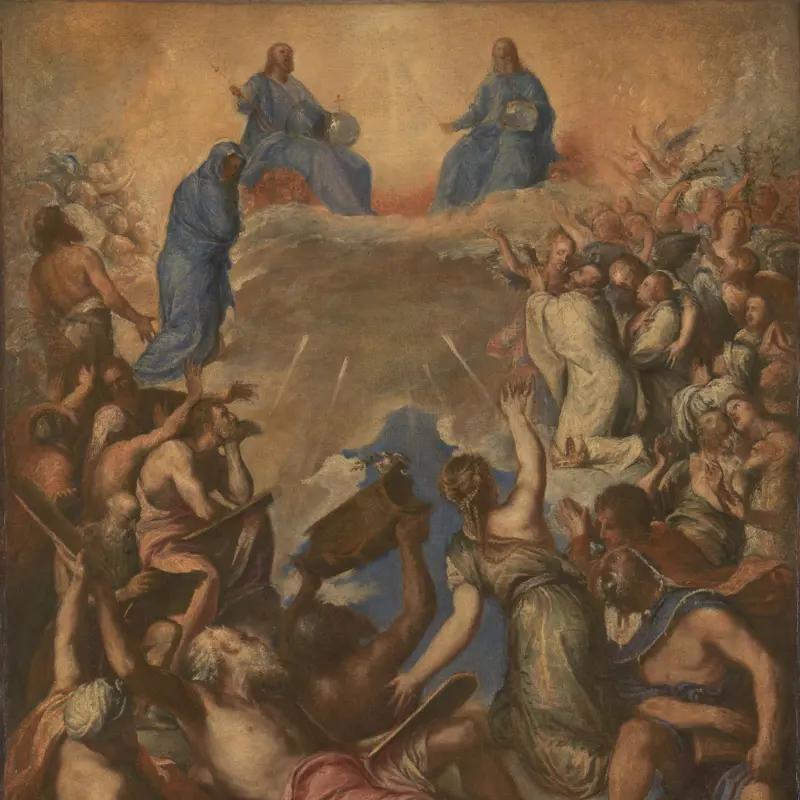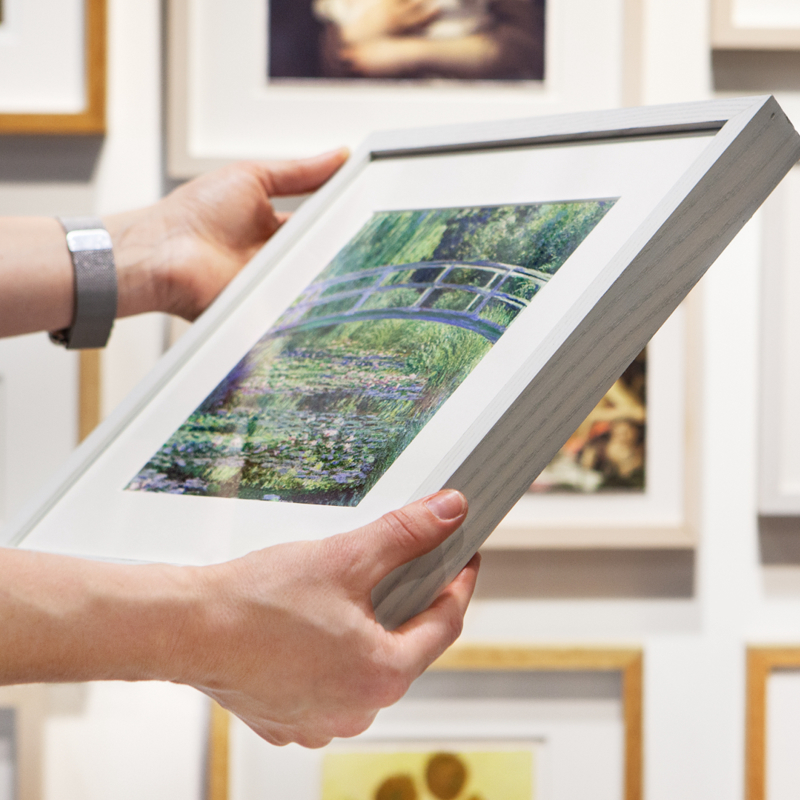Titian, 'Diana and Actaeon', 1556-9
About the work
Overview
While hunting, Actaeon accidentally stumbles upon the secret bathing place of Diana, chaste goddess of the hunt, and sees her naked. His fate is foretold by the stag’s skull on the plinth and the skins of Diana’s former prey hanging above her head. The conclusion of the story is shown in another painting by Titian in the National Gallery, The Death of Actaeon. The outraged goddess changes Actaeon into a stag to be torn apart by his own hounds.
The paintings were part of a famous series of mythological pictures made for King Philip II of Spain when Titian was at the height of his powers. Works of unprecedented beauty and inventiveness, their subjects were mostly based on the Roman poet Ovid’s Metamorphoses – Titian himself referred to them as ‘poesie’ (poems). Diana and Actaeon was designed to be hung together with Diana and Callisto (co-owned by the National Gallery and the National Galleries of Scotland) – their landscape backgrounds and the stream in their foregrounds appear to be continuous.
Audio description
Listen to an audio description of Titian's 'Diana and Actaeon'
Transcript
This is a description of 'Diana and Actaeon', painted between 1556 and 1559 by the Venetian artist, Tiziano Vecellio – or Titian as he is better known. A work of oil on canvas, this is a large painting, over 2 metres wide and about 1.8 metres tall. It has a thick, gold frame decorated with flowing patterns and foliage. Painted for Philip II, the King of Spain, it was part of a series Titian called The Poesie, which depicts various scenes from Ovid’s Metamorphoses.
This painting, Diana and Actaeon, portrays seven almost naked women gathered around a fountain in a shallow pool, in a wooded clearing. They are enclosed by architectural ruins. A young man, a hunter, has stumbled upon them.
The colour pallet is defined by the greens and browns of the forest, the stone ruins, and highlighted by the blue sky in the background. Against this, the bright forms of the women, who are only slightly smaller than life-size, stand out.
Striding in from the left, the hunter wears a light brown, thigh-length tunic, his arms and legs bare. He has open-toed ankle boots with a reddish trim. He has short, curly, dark brown hair, and a quiver of arrows strapped behind his muscular shoulders. He has just pulled aside a hanging piece of red drapery, revealing the young women grouped in the centre and righthand side of the scene. The hunter recoils in surprise, arms lifted. He has dropped his bow which lies on the forest floor.
The seven women appear equally shocked. One is hiding behind a stone column, others hastily reaching for cloths to cover themselves. Three of them recline on the white-stone fountain, which is not flowing, but is partially sunken into the small stream which cuts along the bottom of the painting. The women are white and fair-haired, except for a black woman on the far right of the scene, the only one who has a cloth wrapped around her legs and hips. She appears to be assisting Diana to cover herself with a white veil. Diana sits on a red velvet cloth, another of the women drying one of her feet. Crowned with a braid of pearls running through her golden hair, and topped by a crescent-shaped tiara, Diana glares across the clearing, at the intrusive young man.
These two main characters, the crowned woman and the blundering hunter, are figures from Greco-Roman mythology. They would be best known to Titian through the epic poem, the Metamorphoses, written by the ancient Roman poet, Ovid. In Ovid’s version, Actaeon, a young hunter, has spent the morning hunting with his friends. He accidentally intrudes upon Diana, the chaste Roman goddess of the hunt, who had been bathing with her escort of nymphs. The myth goes on to tell how Diana splashes Actaeon with the water of the sacred spring, and transforms him into a stag. As he runs, Actaeon is hunted down by his own hounds, who tear him to pieces.
Titian has chosen to depict the crucial moment at which Actaeon inadvertently seals his fate, when he locks eyes with the furious Diana. Perched on a stone column behind the women, is the skull of a stag, signalling Acteon’s death. Another grim reminder of Actaeon’s ironic demise is his black and grey hunting dog at his heel, who peeks into the scene from the bottom left corner of the composition. This is balanced by another dog in the bottom right, a toy spaniel, crouching in fury at the intrusion.
Actaeon’s fate is illustrated in another, later work by Titian, 'The Death of Actaeon', which is also in the National Gallery’s collection, along with another painting, 'Diana and Callisto'.
Key facts
Details
- Full title
- Diana and Actaeon
- Artist
- Titian
- Artist dates
- Active about 1506; died 1576
- Date made
- 1556-9
- Medium and support
- Oil on canvas
- Dimensions
- 184.5 × 202.2 cm
- Acquisition credit
- Bought jointly by the National Gallery and National Galleries of Scotland with contributions from the Scottish Government, the National Heritage Memorial Fund, The Monument Trust, Art Fund (with a contribution from the Wolfson Foundation), Artemis Investment Management Ltd, Binks Trust, Mr Busson on behalf of the EIM Group, Dunard Fund, The Fuserna Foundation, Gordon Getty, The Hintze Family Charitable Foundation, J Paul Getty Jnr Charitable Trust, John Dodd, Northwood Charitable Trust, The Rothschild Foundation, Sir Siegmund Warburg's Voluntary Settlement and through public appeal, 2009
- Inventory number
- NG6611
- Location
- Room 8
- Collection
- Main Collection
- Frame
- 21st-century Replica Frame
Provenance
Additional information
Text extracted from the ‘Provenance’ section in Matthias Wivel, ‘Titian: Love, Desire, Death’ (exh. cat. National Gallery, London, 2020), London 2020; for further information, see the full catalogue entry.
Exhibition history
-
2009Rotation of Jointly Owned Work 2009 (NG6611 Titian)National Galleries of Scotland28 January 2009 - 10 September 2009
-
2010Diana and Actaeon Scottish TourAberdeen Art Gallery28 May 2010 - 27 June 2010Kelvingrove Art Gallery and Museum (Glasgow City Council)1 July 2010 - 1 August 2010McManus Galleries6 August 2010 - 5 September 2010
-
2010Titian and the Golden Age of Venetian Painting: Masterpieces from the National Galleries of ScotlandHigh Museum of Art16 October 2010 - 2 January 2011Minneapolis Institute of Art5 February 2011 - 1 May 2011The Museum of Fine Arts (Houston)21 May 2011 - 14 August 2011
-
2012Titian's Diana and ActaeonWalker Art Gallery13 January 2012 - 26 February 2012Norwich Castle Museum & Art Gallery3 March 2012 - 15 April 2012Amgueddfa Cymru — National Museum Wales19 April 2012 - 17 June 2012
-
2012Metamorphosis: Titian 2012The National Gallery (London)11 July 2012 - 23 September 2012
-
2013Rotation of Jointly Owned Works 2013 - 2014 (NG6611 and NG6616 Titian)National Galleries of Scotland1 September 2013 - 31 August 2014
-
2014Titian and the Golden Age of Venetian PaintingScottish National Gallery22 March 2014 - 14 September 2014
-
2017Rotation of Jointly Owned Works 2017 - 2019 (NG6611 and NG6616 Titian)National Galleries of Scotland1 September 2017 - 31 August 2019
-
2020Titian: Love, Desire, DeathThe National Gallery (London)16 March 2020 - 17 January 2021Museo Nacional del Prado2 March 2021 - 4 July 2021Isabella Stewart Gardner Museum10 August 2021 - 2 January 2022
-
2025Rotation of Jointly Owned Works 2025 - 2029 (NG6611 and NG6616 Titian)National Galleries of Scotland1 September 2025 - 31 August 2029
Bibliography
-
1727L.D. de Saint-Gelais, Description des tableaux du Palais Royal: Avec la vie des peintres à la tête de leurs ouvrages: Dédiée à Monseigneur le duc d'Orleans, premier prince du sang, Paris 1727
-
1801J. Britton and E.W. Brayley, The Beauties of England and Wales, 19 vols, London 1801
-
1824W. Buchanan, Memoirs of Painting: With a Chronological History of the Importation of Pictures by the Great Masters into England Since the French Revolution, London 1824
-
1824W. Hazlitt, Sketches of the Principal Picture-Galleries of England, London 1824
-
1836J.D. Passavant, Tour of a German Artist in England, London 1836
-
1843W. Hazlitt, Criticisms on Art and Sketches of the Picture Galleries of England with Catalogues of the Principal Pictures, London 1843
-
1844A.M. Jameson, Companion to the Most Celebrated Private Galleries of Art in London: Containing Accurate Catalogues, Arranged Alphabetically, for Immediate Reference, Each Preceded by an Historical & Critical Introduction […], London 1844
-
1854G.F. Waagen, Treasures of Art in Great Britain: Being and Account of the Chief Collections of Paintings, Drawings, Sculptures, Illuminated Mss. […], vol. 2, trans. E. Eastlake, London 1854
-
1877J.A. Crowe and G.B. Cavalcaselle, Titian: His Life and Times, London 1877
-
1878G. Vasari, Le vite de'più eccellenti pittori, scultori ed architettori: Con nuove annotazioni e commenti di Gaetano Milanesi, ed. G. Milanesi, 8 vols, Florence 1878
-
1933W. Suida, Tiziano: 304 tavole in fototipia, Rome 1933
-
1933R. Fry and S.K. North, 'The Bridgewater Titians', The Burlington Magazine, LXII/358, 1933, pp. 3-15
-
1936H. Tietze, Titian: Leben und Werk, 2 vols, Vienna 1936
-
1952E.K. Waterhouse, Titian's Diana and Actaeon, Oxford 1952
-
1955G.A. Dell'Acqua, Tiziano, Milan 1955
-
1955O.J. Brendel, 'Borrowings from Ancient Art in Titian', Art Bulletin, XXXVII/2, 1955, pp. 113-25
-
1957M. William, Illustrated Catalogue of Thirty Pictures in the Collection of His Grace the Duke of Sutherland, London 1957
-
1960F. Valcanover, Tutta la pittura di Tiziano, Milan 1960
-
1968L. Skarsgård, Research and Reasoning. A Case Study on a Historical Inquiry: Titian's Diana and Actaeon. A Study in Artistic Innovation, Göteborg 1968
-
1969R. Pallucchini, Tiziano, Florence 1969
-
1969E. Panofsky, Problems in Titian, Mostly Iconographic, New York 1969
-
1969F. Valcanover, L'opera completa di Tiziano, Milan 1969
-
1969H.E. Wethey, The Paintings of Titian: The Religious Paintings, 3 vols, London 1969
-
1971S.J. Freedberg, Painting in Italy: 1500 to 1600, Harmondsworth 1971
-
1974J. Wilde, Venetian Art from Bellini to Titian, Oxford 1974
-
1974M.C. Tanner, 'Chance and Coincidence in Titian's Diana and Actaeon', Art Bulletin, LVI/1, 1974, pp. 535-50
-
1975A.S. Wethey and M.C. Tanner, 'Letters to the Editor', Art Bulletin, LVII/4, 1975
-
1978H. Brigstocke, Italian and Spanish Paintings in the National Gallery of Scotland, 1st edn, Edinburgh 1978
-
1978S. Holo, 'A Note on the Afterlife of the Crouching Aphrodite in the Renaissance', J. Paul Getty Museum Journal, VI-VII, 1978, pp. 23-36
-
1980C. Hope, Titian, London 1980
-
1980A. Gentili, 'Il significato allegorico della caccia nelle "Poesie" di Tiziano', in Tiziano e Venezia: Convegno internazionale di studi, Venezia, 1976, Venice 1980, pp. 169-78
-
1981J.C. Nash, Poesie for Philip II, Phd Thesis, John Hopkins University 1981
-
1981M. Crawford Volk, 'Rubens in Madrid and the Decoration of the King's Summer Apartments', The Burlington Magazine, CXXIII/942, 1981, pp. 513-29
-
1985J.C. Nash, Veiled Images: Titian's Mythological Paintings for Philip II, Philadelphia 1985
-
1988A. Gentili, Da Tiziano a Tiziano: Mito e allegoria nella cultura veneziana del Cinquecento, Rome 1988
-
1991D. West, 'Lucretius and the Poetry of Argument', Renaissance Studies, V/3, 1991, pp. 242-9
-
1993H. Brigstocke, Italian and Spanish Paintings in the National Gallery of Scotland, 2nd edn, Edinburgh 1993
-
1993T. Pignatti, 'Abozzi and Ricordi: New Observations on Titian's Technique', in J. Manca (ed.), Titian 500: 25th Symposium, Washington 1993, pp. 73-83
-
1994F. Checa, Tiziano y la monarquía hispánica: Usos y funciones de la pintura veneciana en España (siglos XVI y XVII), Madrid 1994
-
1995M. Haen, 'Tizians Diana Und Actaeon: Der offenbar gewordene Mythos im Geist der griechischen Religion', Zeitschrift fur Asthetik und Allgemeine Kunstwissenschaft, XL/1, 1995, pp. 59-75
-
1996W.R. Rearick, 'Titian's Later Mythologies', Artibus et historiae, XVII/33, 1996, pp. 23-67
-
1997R. Goffen, Titian's Women, New Haven 1997
-
1998M. Mancini, Tiziano e le corti d'Asburgo nei documenti degli archivi spagnoli, Venice 1998
-
2001F. Pedrocco, Titian: The Complete Paintings, London 2001
-
2003D. Jaffé (ed.), Titian, London 2003
-
2004A. Anselmi, Il diario del viaggio in Spagna del Cardinale Francesco Barberini scritto da Cassiano dal Pozzo, Madrid 2004
-
2004J. Lawson, 'Titian's Diana Pictures: The Passing of an Epoch', Artibus et historiae, XXV/49, 2004, pp. 49-63
-
2004P. Humfrey, The Age of Titian: Venetian Renaissance Art from Scottish Collections (exh. cat. National Gallery of Scotland, 5 August - 5 December 2004), Edinburgh 2004
-
2005T. Puttfarken, Titian and Tragic Painting: Aristotle's Poetics and the Rise of the Modern Artist, New Haven 2005
-
2007P. Humfrey, Titian: The Complete Paintings, Ghent 2007
-
2007P. Humfrey, Titian, London 2007
-
2009National Gallery, The National Gallery: Review of the Year, April 2008 - March 2009, London 2009
About this record
If you know more about this work or have spotted an error, please contact us. Please note that exhibition histories are listed from 2009 onwards. Bibliographies may not be complete; more comprehensive information is available in the National Gallery Library.

